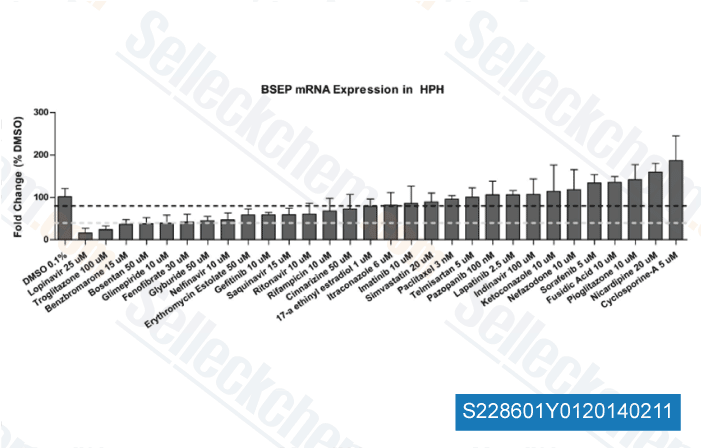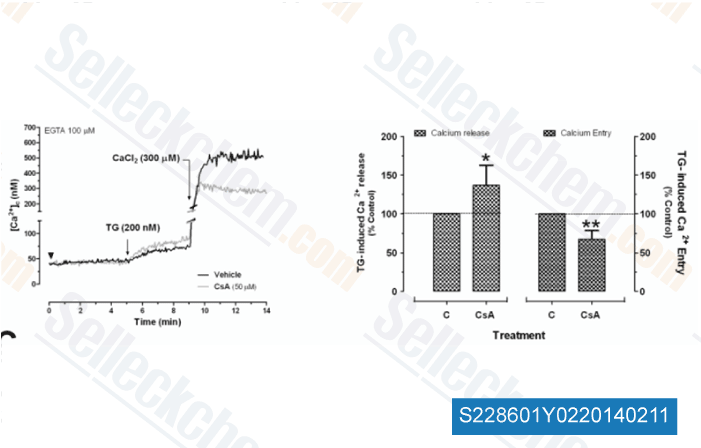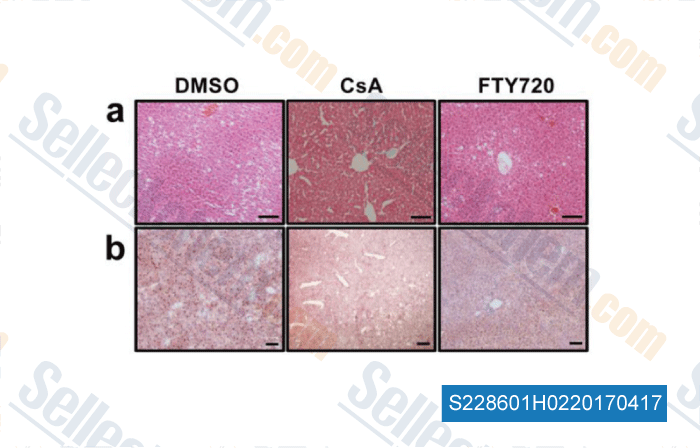|
Toll Free: (877) 796-6397 -- USA and Canada only -- |
Fax: +1-832-582-8590 Orders: +1-832-582-8158 |
Tech Support: +1-832-582-8158 Ext:3 Please provide your Order Number in the email. |
Technical Data
| Formula | C62H111N11O12 |
||||||
| Molecular Weight | 1202.61 | CAS No. | 59865-13-3 | ||||
| Solubility (25°C)* | In vitro | DMSO | 100 mg/mL (83.15 mM) | ||||
| Ethanol | 100 mg/mL (83.15 mM) | ||||||
| Water | Insoluble | ||||||
| In vivo (Add solvents to the product individually and in order) |
|
||||||
|
* <1 mg/ml means slightly soluble or insoluble. * Please note that Selleck tests the solubility of all compounds in-house, and the actual solubility may differ slightly from published values. This is normal and is due to slight batch-to-batch variations. * Room temperature shipping (Stability testing shows this product can be shipped without any cooling measures.) |
|||||||
Preparing Stock Solutions
Biological Activity
| Description | Cyclosporin A, a non-polar cyclic oligopeptide, is an immunosuppressive agent that binds to cyclophilin and then inhibits calcineurin with IC50 of 7 nM in a cell-free assay. Cyclosporin A is generally given following transplant surgery to prevent rejection and has been used to test its toxic effect on a perfused 3D proximal tubule model. | ||
|---|---|---|---|
| Targets |
|
||
| In vitro | Cyclosporin A binds to the cyclophilin (immunophilin) in T cells[1] , forms a Cyclophilin-Cyclosporin A complex which the binds to and inhibits calcineurin. [2] Cyclosporin A inhibits calcineurin with IC50 of 7 nM[3], then blocks the nuclear translocation of NF-AT. [4] Cyclosporin A also affects mitochondria by preventing the MTP (mitochondrial permeability transition pore) from opening with an IC50 of 39 nM. [5] |
||
| In vivo | Cyclosporin A is an immunosuppressive agent that is effective following either parenteral or oral administration in mice, rat and guinea pigs. [6], is clinically used in organ transplantation to prevent rejection. [7] |
Protocol (from reference)
| Kinase Assay: |
|
|---|---|
| Cell Assay: |
|
| Animal Study: |
|
References
Customer Product Validation

-
Data from [Biochim Biophys Acta, 2013, 1833(3), 652-62]

-
Data from [Biochim Biophys Acta, 2013, 1833(3), 652-62]

-
Data from [Data independently produced by , , Pharm Res, 2016, 33(2):395-403]
Selleck's Cyclosporin A has been cited by 111 publications
| A new class of capsid-targeting inhibitors that specifically block HIV-1 nuclear import [ EMBO Mol Med, 2024, 16(11):2918-2945] | PubMed: 39358603 |
| LKB1 prevents ILC2 exhaustion to enhance antitumor immunity [ Cell Rep, 2024, S2211-1247(23)01591-7] | PubMed: 38670109 |
| Melatonin protects RPE cells from necroptosis and NLRP3 activation via promoting SERCA2-related intracellular Ca2+ homeostasis [ Phytomedicine, 2024, 135:156088] | PubMed: 39341129 |
| Negative cell cycle regulation by calcineurin is necessary for proper beta cell regeneration in zebrafish [ Elife, 2024, 12RP88813] | PubMed: 39383064 |
| Calcineurin-dependent contributions to fitness in the opportunistic pathogen Candida glabrata [ mSphere, 2024, 9(1):e0055423] | PubMed: 38171022 |
| Amanitin-induced variable cytotoxicity in various cell lines is mediated by the different expression levels of OATP1B3 [ Food Chem Toxicol, 2024, 188:114665] | PubMed: 38641045 |
| Select EZH2 inhibitors enhance viral mimicry effects of DNMT inhibition through a mechanism involving NFAT:AP-1 signaling [ Sci Adv, 2024, 10(13):eadk4423] | PubMed: 38536911 |
| The cGAS-STING pathway-dependent sensing of mitochondrial DNA mediates ocular surface inflammation [ Signal Transduct Target Ther, 2023, 8(1):371] | PubMed: 37735446 |
| The cGAS-STING pathway-dependent sensing of mitochondrial DNA mediates ocular surface inflammation [ Signal Transduct Target Ther, 2023, 8(1):371] | PubMed: 37735446 |
| Three-dimensional nanofibrous sponges with aligned architecture and controlled hierarchy regulate neural stem cell fate for spinal cord regeneration [ Theranostics, 2023, 10.7150/thno.87288] | PubMed: 37771775 |
RETURN POLICY
Selleck Chemical’s Unconditional Return Policy ensures a smooth online shopping experience for our customers. If you are in any way unsatisfied with your purchase, you may return any item(s) within 7 days of receiving it. In the event of product quality issues, either protocol related or product related problems, you may return any item(s) within 365 days from the original purchase date. Please follow the instructions below when returning products.
SHIPPING AND STORAGE
Selleck products are transported at room temperature. If you receive the product at room temperature, please rest assured, the Selleck Quality Inspection Department has conducted experiments to verify that the normal temperature placement of one month will not affect the biological activity of powder products. After collecting, please store the product according to the requirements described in the datasheet. Most Selleck products are stable under the recommended conditions.
NOT FOR HUMAN, VETERINARY DIAGNOSTIC OR THERAPEUTIC USE.
